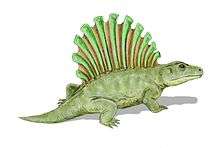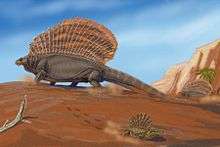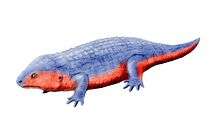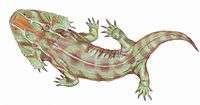Platyhystrix
Platyhystrix (meaning "flat porcupine") was a temnospondyl amphibian with a distinctive sail along its back, similar to the unrelated synapsids, Dimetrodon and Edaphosaurus. It lived during the boundary between the latest Carboniferous and earliest Permian periods in Texas, about 300 million years ago.
| Platyhystrix | |
|---|---|
 | |
| Scientific classification | |
| Kingdom: | Animalia |
| Phylum: | Chordata |
| Order: | †Temnospondyli |
| Family: | †Dissorophidae |
| Genus: | †Platyhystrix Williston, 1911 |
| Species | |
| |
Palaeobiology

Platyhystrix may have been preyed upon by larger temnospondyls such as Eryops, or by larger carnivorous reptiles, which were becoming more common and diverse in the drier climate of the Permian. The skull was large and strongly built, with a frog-like face. Platyhystrix had a compact body, reaching 1 metre (3.3 ft) long including the tail, and its short, sturdy legs indicate a mainly terrestrial life.[1]
Platyhystrix appeared rather unusual: the dorsal vertebrae were extraordinarily lengthened, and in life they probably formed a skin-covered sail. This structure was possibly for thermal regulation, as in other animals of similar appearance, such as the pelycosaurs Dimetrodon and Edaphosaurus. The back of Platyhystrix was also covered with thick hard plates, similar to those of its near relative, Cacops.[1]
References
- Palmer, D., ed. (1999). The Marshall Illustrated Encyclopedia of Dinosaurs and Prehistoric Animals. London: Marshall Editions. p. 52. ISBN 1-84028-152-9.
- Vertebrate Palaeontology by Michael J. Benton and John Sibbick
- The Simon & Schuster Encyclopedia of Dinosaurs and Prehistoric Creatures: A Visual Who's Who of Prehistoric Life by Barry Cox, Colin Harrison, R.J.G. Savage, and Brian Gardiner
- Bibliography Of Fossil Vertebrates 1934-1938 by C. I. Camp


